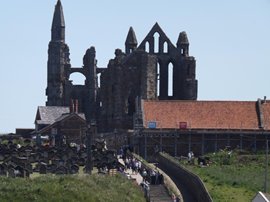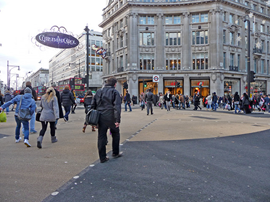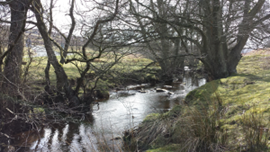The potential of community-led heritage
The challenge for the Heritage Trust Network is to raise awareness of the untapped potential of its member charities, community organisations and social enterprises.

|
| A community engagement event combining building archaeology and Minecraft (Photo: The Ridge). |
Who are the custodians of the UK’s heritage? The National Trust and English Heritage, Cadw, National Trust for Scotland or Historic Scotland? The Church of England is the custodian of the most listed buildings, and the Canal & River Trust comes third behind the National Trust. Some of the stately homes are still in private ownership. Many more small-scale historic sites are in everyday use as privately or publicly owned buildings and spaces.
There is a another, important piece of the jigsaw, a growing segment of heritage custodians, rescuing, restoring and reusing historic buildings, structures and spaces. These are the charities, community organisations and social enterprises that form the Heritage Trust Network.
A year ago I started working for network as its first chief executive. This was part of a process of renewal and transformation which has been supported by major funding from the National Lottery Heritage Fund and Historic England. What has struck me most about the network is its diversity. I am not talking about diversity in the sense of ethnicity, disability and so on. Like most of the heritage sector we still have a lot of work to do in that regard. However, the network is incredibly diverse in the range of organisations that are members, the types of historic sites they are working on, and the facilities and services that those sites provide. No longer is this simply a movement for traditional building preservation trusts (more about those later).
Once the network’s members have completed the epic process of building and land restoration, their sites provide visitor attractions, business premises, artists’ studios, homes, shops, cafes, gardens and community facilities. The size of site restored and managed is also diverse. My original experience of community-led restoration started in the 1990s in Spon End, Coventry, where a local trust was formed to rescue a terrace of six medieval cottages. That trust is still a member of the network. At the other end of the scale, one of our members, Wentworth Woodhouse, near Rotherham, is a Grade I stately home on a scale matching any in the National Trust’s portfolio. There is also a growing section of our membership which consists of ‘accidental custodians’, community organisations that are not dedicated to preserving heritage but have taken on a historic building because it suits their needs. Refugee Education UK in London, which has taken on a former bank building, and Circus Eruption in Swansea, now custodians of a former church, are typical examples.
When we asked our members how they had coped through the period of Covid-19 restrictions, some had not been affected at all, some had been fully compensated by measures such as furloughing and emergency funding, a proportion had lost out financially, and a very small number were facing an existential crisis. This illustrates how diverse are the needs of our members in terms of government action and public policy. However, in many respects our members’ needs are no different from those of the rest of the heritage sector (our members get as frustrated by the VAT regime as any others). As a lean organisation, the Heritage Trust Network puts its energies into providing advice and guidance to our members, and facilitating peer support and networking. We support other bodies such as the Heritage Alliance and IHBC to lobby government on the sector’s behalf.
Where we do think we have a campaigning and advocacy job to do, is in raising awareness of the potential of community-led heritage initiatives to providing solutions to many of the challenges our society is currently facing.
Take the crisis in our high streets. A number of our members are leading local efforts to bring new life into town and city centres, hit by out-of-town, then online retail and, more recently, by Covid-19. As centres find a new future which is not as a place to go to deal with the necessities of life, but as destinations for culture, leisure, hospitality and diverse interactions with other humans, historic streetscapes provide a compellingly authentic setting. Historic Coventry Trust is managing the national demonstrator project for the high street heritage action zones, restoring 15 buildings in the Burges and Hale Street in a vibrant streetscape full of independent businesses. These are among the 22 buildings that Historic Coventry is working on in a ground-breaking asset-transfer initiative.
While changes in funding regimes, economics and the market for historic buildings has seen a decline in the traditional ‘revolving’ model of building preservation trusts, this new generation of multi-project trusts is proving its worth to local economies. Recognising this, our colleagues in the Architectural Heritage Fund have developed the Heritage Development Trust initiative to highlight the role that these dynamic building preservation trusts can play in high-street regeneration. For regeneration professionals, and politicians, the traditional answer to town-centre decline was comprehensive redevelopment, a new shopping centre or an anchor store. Our challenge is to persuade them that we are entering a new era where a more fine-grained approach is required, with quality of place at its core.
As we emerge from the pandemic, the importance of outdoor spaces in sustaining people’s mental health and general wellbeing has been widely recognised. For many of our members with outdoor spaces these have been the only parts of their sites able to welcome visitors for much of the past year. This is another area where historic environments have untapped potential to contribute to public policy goals.
Riverside House Stourbridge is an organisation that has taken over a post-industrial river and canal-side site historically associated with the steel industry. It has not yet restored the historic buildings on its site but is already providing what has been recognised by local public health officials as a flagship health and wellbeing centre, offering therapeutic craft and land-based activities for people with a variety of needs. Similarly, The Ridge, an organisation in Dunbar, Scotland, is providing training in traditional skills for people with troubled backgrounds while restoring high-street buildings and providing volunteering opportunities for local residents in community gardens created in the burgage plots behind them.
Whether it is reborn building preservation trusts working dynamically, in partnership with local councils, to turn the problem of buildings at risk into an opportunity for regeneration, or community organisations using the historic environment as a platform for initiatives to improve people’s health and wellbeing, the network’s members are injecting a new sense of purpose into conservation. Our challenge is to raise awareness of that potential in local and national government, and among policy and decision makers more widely.
This article originally appeared in Context 169, published by the Institute of Historic Building Conservation (IHBC) in September 2021. It was written by David Tittle, chief executive of the Heritage Trust Network.
--Institute of Historic Building Conservation
Related articles on Designing Buildings
- Characterising Neighbourhoods: exploring local assets of community significance.
- Community engagement in conservation.
- Conservation.
- English Heritage.
- Great Yarmouth Preservation Trust.
- Heritage.
- Historic Buildings.
- IHBC articles.
- London Historic Buildings Trust resilient heritage project.
- National Trust.
IHBC NewsBlog
Notre-Dame Cathedral of Paris reopening: 7-8 December
The reopening is in time for Christmas 2025.
Stirling Prize-winning Salford building to be demolished
The Centenary Building will be bulldozed as part of the wider £2.5bn Crescent regeneration project
Volunteers work to transform 100-year-old ‘hidden’ building into bothy
The building, named Druimnashallag, is located southeast of Oban.
The new ‘Arches for HERs’ Demo site, from the Getty Conservation Institute via HE
It shows how organisations responsible for historic environment records (HER) management can benefit from its powerful features.
ICOMOS-CIF 2024 Symposium celebrates 40th anniversary in Venice
It aims to critically review current practices and theories of conservation of built heritage around the world, and more.
HES establishes new national centre for retrofit of traditional buildings
HES plans to develop the centre follows £1m of funding from UKRI Arts and Humanities Research Council.
High Court rejects oral appeal against tower block decision in historic Bloomsbury
The request was for a full Judicial Review hearing against Camden Council’s approval of a 74m-high tower block in Bloomsbury.
Mayor of London and Government announce bold plans to transform Oxford Street
Plans include turning the road into a traffic-free pedestrianised avenue, creating a beautiful public space.
Crystal Palace Subway, for 160th anniversary
The remarkable Grade II* listed Crystal Palace Subway in South London begins a new era following major restoration.
National Trust brings nature back to an area twice the size of Manchester in less than a decade
The National Trust has achieved its aim of creating or restoring 25,000 hectares of priority habitat on its land by 2025.
















